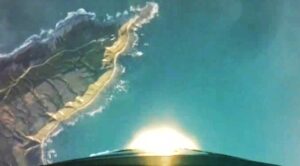Rocket Lab launches satellites for Spaceflight

WASHINGTON — A Rocket Lab Electron rocket launched an Earth imaging satellite and several smaller satellites on a mission for rideshare services company Spaceflight June 29.
The Electron lifted off from Rocket Lab’s Launch Complex 1 on New Zealand’s Mahia Peninsula at 12:30 a.m. Eastern, with the rocket’s upper stage deploying the satellites into low Earth orbit 53 minutes later. The launch was delayed two days by problems with ground tracking equipment that Peter Beck, the company’s founder and chief executive, said will soon be phased out in favor of an autonomous flight termination system.
Rocket Lab carried out the launch for Spaceflight, the Seattle-based company that offers rideshare services on a variety of vehicles. The launch is the first of as many as five Electron missions this year for Spaceflight, carrying a mix of small satellites.
The largest satellite on this mission is Global-3 for Earth imaging company BlackSky. The satellite, weighing about 60 kilograms, will be the company’s first to go into a medium-inclination orbit, providing faster revisit times over selected areas of the Earth.
“As we continue our constellation expansion, it will be critical to leverage the frequent launch cadence Spaceflight offers through Rocket Lab and others, and we’re excited to be on this inaugural mission,” Brian O’Toole, chief executive of BlackSky, said in the statement.
Six other satellites are also on the rocket, bring the total payload mass to the mission to approximately 80 kilograms. Two of the satellites are Prometheus cubesats for U.S. Special Operations Command, believed to be used for tactical communications. Two others are SpaceBEE smallsats for Swarm, a company developing a constellation of such satellites for Internet of Things services. The fifth satellite is ACRUX-1, an Australian student-built cubesat, and the sixth is for an undisclosed customer.
Launching on Electron offers a new approach for Spaceflight, which has traditionally provided launches for smallsats as secondary payloads on larger launch vehicles. The company did purchase a dedicated Falcon 9 mission, called SSO-A, that launched 64 satellites last December.
Electron offers the company the ability to provide dedicated launches, with control over orbit and schedule, but for smaller numbers of satellites at a time. “Having the Electron in our arsenal of small launch vehicles provides our customers with a low-cost, flexible option to get on orbit,” Curt Blake, chief executive of Spaceflight, said in a pre-launch statement.
The mission was the third of 2019 for Spaceflight, after a mission in February where it launched SpaceIL’s Beresheet launch as a secondary payload on a Falcon 9 and one in March that launched 21 satellites as secondary payloads on an Indian Polar Satellite Launch Vehicle. Speaking at the Space Enterprise Summit here June 26, Blake said the company planned to perform as many as 19 launches in 2019.
“What we try to do is buy up the excess capacity on all these different launch vehicles to drive efficiencies,” he said at the summit. “Launch is a scarce resource, and it’s really important that we use all the performance of those launch vehicles to get as much into orbit as we can, because that drives launch costs lower.”
The launch was the third this year for Rocket Lab’s Electron small launch vehicle. The Electron launched DARPA’s Radio Frequency Risk Reduction Deployment Demonstration (R3D2) satellite in March, and three technology demonstration satellites for the U.S. Air Force in May.
Lars Hoffman, senior vice president of global launch services at Rocket Lab, said during a June 6 panel discussion at the National Space Society’s International Space Development Conference that the company plans to move towards monthly launches of Electron after this mission.
“The value that we bring to the market is being able to launch on a monthly cadence,” he said, providing assurances to companies, and their investors, that their payloads can get into orbit on schedule. “There’s a lot of pent-up demand.”
from SpaceNews.com https://ift.tt/2LpZpad
Comments
Post a Comment